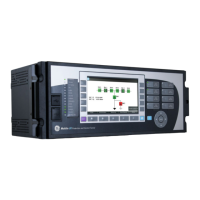5-336 D60 Line Distance Protection System GE Multilin
5.7 CONTROL ELEMENTS 5 SETTINGS
5
The scheme generates output operands (DIR BLOCK TX INIT and DIR BLOCK TX1 STOP through DIR BLOCK TX4 STOP) that
control the transmission of signals to the remote end(s). When used with telecommunications facilities the output operands
should be assigned to operate output contacts connected to key the transmitter at the interface.
The output operands from the scheme (DIR BLOCK A, B, C and 3P) must be configured to interface with other relay func-
tions, output contacts in particular, in order to make the scheme fully operational. Typically, the output operand should be
programmed to initiate a trip, breaker fail, and autoreclose, and drive a user-programmable LED as per user application.
When used in conjunction with the trip output element, the scheme is pre-configured to initiate trip, breaker fail, and single-
pole autoreclose actions.
• BLOCK SCHEME BLOCK: This setting allows the user to assign any FlexLogic operand to block the scheme. Contact
inputs from a pilot cut-out switch are typically used for this purpose.
• BLOCK RX CO-ORD PKP DELAY: This setting defines a delay for the forward-looking protection elements used by
the scheme for coordination with the blocking response from the remote end(s). This setting should include both the
response time of the protection elements used to establish a blocking signal and the total transmission time of that sig-
nal including the relay communications equipment interfacing and the communications channel itself.
• TRANS BLOCK PICKUP DELAY: This setting defines a transient blocking mechanism embedded in the blocking
scheme for coping with the exposure of both the over-reaching zone 2 and ground directional overcurrent function to
current reversal conditions.
The transient blocking logic applies to the send path only. Identifying the fault as a reverse fault establishes the block-
ing signal. If the reverse fault condition prevails for
TRANS BLOCK PICKUP DELAY, the blocking operation will be
extended by the transient blocking timer for TRANS BLOCK RESET DELAY. This allows riding through current reversal
conditions. However, if zone 1 picks up during the transient blocking condition, the blocking action is removed. This is
done to cope with evolving faults when an external fault is followed by an internal fault. Without the zone 1 feedback,
the trip would be unnecessarily delayed.
The
TRANS BLOCK PICKUP DELAY should not be longer than the fastest possible trip time for faults on an adjacent line
so that the extended blocking action could be established. This should take into account the pickup time of the reverse-
looking elements of the scheme. The delay defined by this setting should not be too short in order to avoid locking up a
spurious reverse fault indication that can occur during internal fault conditions.
• TRANS BLOCK RESET DELAY: This setting defines a transient blocking mechanism embedded in the blocking
scheme for coping with the exposure of the overreaching protection functions to current reversal conditions (see also
the
TRANS BLOCK PICKUP DELAY).
This delay should be selected long enough to cope with transient conditions including not only current reversals but
also spurious negative and zero-sequence currents occurring during breaker operations (in the case when neutral
directional or negative-sequence directional overcurrent functions are used). Breaker failure time of the surrounding
protection systems within the reach of the ground directional function used by the blocking scheme should be consid-
ered to make sure that the ground directional function is not jeopardized during delayed breaker operations.
• BLOCK SCHEME SEAL-IN DELAY: The output FlexLogic operand (
DIR BLOCK OP) is produced according to the
Blocking scheme logic. The BLOCK SCHEME SEAL-IN DELAY defines a minimum guaranteed duration of the DIR BLOCK
OP
pulse. As this operand runs the Trip Table of the Blocking scheme, the trip operands DIR BLOCK TRIP A, B, C and 3P
are sealed-in for the same period of time.
• GND DIR O/C FWD: This setting defines the FlexLogic operand (if any) of a protection element used in addition to
zone 2 for identifying faults on the protected line, and thus, for initiating operation of the scheme. Good directional
integrity is the key requirement for an over-reaching forward-looking protection element used as
GND DIR O/C FWD.
Even though any FlexLogic operand could be used as
GND DIR O/C FWD enabling the user to combine responses of var-
ious protection elements or to apply extra conditions through FlexLogic equations, this extra signal is primarily meant
to be the output operand from either the negative-sequence directional or neutral directional overcurrent elements.
Both these elements have separate forward (
FWD) and reverse (REV) output operands.
The forward indication should be used (NEG SEQ DIR OC1 FWD or NEUTRAL DIR OC1 FWD). The selected protection ele-
ment (or elements in combination) should be coordinated with the selection of
GND DIR O/C REV. For all the forward
external faults seen by an element used as
GND DIR O/C FWD at one end of the line, the reverse-looking element used
as
GND DIR O/C REV at the other end should pickup and provide a blocking signal. For greater security and to overcome
spurious directional element operation during transients, adding at least 0.5 cycles of pickup delay to the forward direc-
tional element is recommended.

